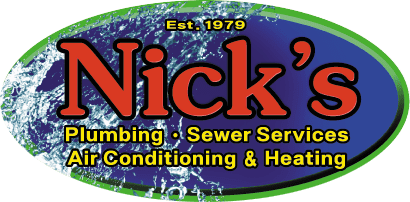Author: Jeff O'Hara
There are few statements a professional service provider can make to a homeowner that strikes as much fear into their hearts as “You need a new furnace.” Heck, you live in Houston. You weren’t even sure you had a furnace, yet here you are, staring at an estimate for several thousand dollars to replace an appliance that hardly gets any use here in the South. Doesn’t seem fair.
Well, like life, HVAC repair and maintenance isn’t fair, and sometimes it can be downright expensive. Fortunately, there are many steps the homeowner can take to mitigate the financial hit, from choosing more efficient equipment that will save money over time to purchasing equipment that comes with rebates or tax breaks that can be realized more quickly.
Nick’s Air Conditioning can help you determine if your underperforming drafty furnace has reached the end of its useful life and what the best solution for your home would be.
To Repair My Furnace, or Install a New Furnace? That is the Question
Deciding whether to repair or replace a furnace depends on various factors, including the furnace’s age, the extent of the issue, and its efficiency. Generally, if your furnace is relatively new, say less than ten years old, and experiences a minor repair like a faulty thermostat or a minor gas valve issue, it’s often more cost-effective to have it repaired.
However, if your furnace is older and nearing the end of its expected lifespan, replacing it may make more sense, especially if the repair costs are substantial. One rule of thumb we use at Nick’s is anytime a repair will cost more than 50% of the replacement cost, we err on the side of replacement.
Efficiency is another crucial consideration. Suppose your furnace has a low Annual Fuel Utilization Efficiency (AFUE) rating, and you’re experiencing frequent breakdowns. In that case, investing in a new, high-efficiency furnace might be more economical in the long run. A new furnace can provide better comfort, lower energy bills, and reduce environmental impact. Additionally, if your furnace poses safety concerns due to carbon monoxide leaks or other hazardous issues, replacing it is imperative for your family’s safety.
Consulting with a qualified Nick’s HVAC technician can help you assess your situation and decide on furnace repair or replacement. We can provide guidance based on factors like the furnace’s condition, your budget, and your long-term heating needs.
Things to Consider When Installing a New Furnace
Fuel Type
When installing a new furnace, one of the crucial factors to consider is the type of fuel it will run on, and this decision often hinges on the availability of fuel sources in your area.
Natural gas furnaces are popular due to their efficiency and cost-effectiveness but require access to a natural gas supply line.
If natural gas isn’t readily available in your location, propane furnaces can be a viable alternative. Propane is stored in tanks on your property, offering more flexibility in fuel access, but it does require regular refills.
An electric furnace is a reliable option for areas without natural gas or propane access, as it relies on the electrical grid. However, electric furnaces are less energy-efficient and may lead to higher utility bills in the long run.
Ultimately, the availability of fuel sources in your area plays a crucial role in determining the most suitable furnace for your home, ensuring you have a reliable and efficient heating system tailored to your needs.
Furnace Efficiency
When selecting a furnace, it’s essential to consider its efficiency category to ensure you get the most cost-effective and eco-friendly option for your home. Furnace efficiency is typically measured by its Annual Fuel Utilization Efficiency (AFUE) rating, representing the percentage of energy converted into usable heat. Higher AFUE ratings indicate more significant efficiency. For example, a furnace with an AFUE rating of 95% converts 95% of the fuel into heat, while the remaining 5% is lost as waste.
Choosing a furnace with a higher AFUE rating may lead to reduced energy consumption and lower heating bills over time, making it a wise long-term investment. However, balancing efficiency with your budget is essential, as furnaces with higher AFUE ratings often incur a higher upfront cost. Selecting the right efficiency category for your furnace ensures optimal comfort and savings while minimizing environmental impact.
In addition to AFUE ratings, the Seasonal Energy Efficiency Ratio (SEER) rating is a crucial metric when considering a furnace, as it directly impacts your heating system’s energy efficiency and operational costs. A higher SEER rating signifies a more efficient furnace that can provide superior comfort while consuming less energy. This efficiency translates to lower utility bills and reduced environmental impact.
Investing in a furnace with a higher SEER rating saves you money over time and contributes to a more sustainable and eco-friendly home heating solution. It’s important to carefully assess your heating needs and budget while considering the SEER rating to find the right balance between efficiency and cost-effectiveness.
Square Footage of the Home
Choosing a furnace with the appropriate heating capacity ensures your home stays warm during winter. Furnaces are typically sized in British Thermal Units (BTUs) per hour, and matching the furnace’s output to your home’s square footage is essential. If the furnace is too small, it may struggle to keep your home adequately heated, leading to discomfort and potentially higher energy bills as it runs continuously.
On the other hand, if the furnace is oversized for your space, it can lead to short cycling, uneven heating, and increased energy consumption. To make an informed decision, it’s advisable to consult with a professional HVAC technician who can assess your home’s specific needs and recommend the right furnace size based on square footage, insulation, and other factors to ensure optimal heating efficiency and comfort.
Local Climate and Weather Factors
The climate directly impacts how much heating power your furnace needs to provide to maintain a comfortable indoor temperature. In colder climates with harsh winters, a high-efficiency furnace with a greater heating capacity may be necessary to combat extreme cold temperatures effectively. Conversely, a lower heating capacity furnace may suffice in milder climates to keep your home warm during the cooler months.
It’s essential to strike the right balance between heating capacity and energy efficiency, as choosing a furnace that matches your local climate can help you optimize comfort while minimizing energy costs. Consulting with a professional HVAC technician familiar with your region’s climate can provide valuable insights into selecting the most suitable furnace for your needs.
Your Family’s Comfort Requirements
Consider factors such as the size and layout of your living spaces, the number of occupants, and individual preferences for temperature control. A multi-zone heating system, for instance, can provide customized comfort by allowing different areas of your home to be heated to different temperatures. This is especially useful if you have family members with varying comfort needs.
Additionally, programmable thermostats and smart HVAC systems can enhance control and comfort by allowing you to adjust temperatures remotely and schedule heating cycles based on your family’s daily routines.
Efficiency is another key consideration. While prioritizing comfort, choosing a furnace that operates efficiently to minimize energy consumption and reduce heating costs is essential. Modern, energy-efficient furnaces often feature variable-speed blower motors, two-stage heating, or modulating gas valves that adjust the heat output based on the heating demand, further enhancing efficiency.
Your Nick’s Air Conditioning technician can assess your family’s comfort needs and recommend a furnace that balances comfort and efficiency, ensuring your home stays cozy while keeping energy bills in check.
Warranty
While you’re busy worrying about installing your new furnace, dealing with the installation, and the chaos of getting your home back to normal, it’s easy to overlook details. One of the most common mistakes when installing any major appliance is not enquiring enough about the warranty or not taking the time to read the warranty paperwork provided by the manufacturer or your HVAC contractor.
Take a few minutes—at a minimum—to at least familiarize yourself with the most critical aspects of any warranty: how long it lasts and what it covers.
Length of Warranty
The duration of the warranty is a critical factor. Different furnace manufacturers offer varying warranty lengths, typically 10 to 20 years for the heat exchanger and 5 to 10 years for other components. A longer warranty period can indicate the manufacturer’s confidence in their product’s durability. However, it’s essential to understand what parts of the furnace are covered for and how long, as warranties may differ for different components.
A new furnace warranty typically covers a range of components and potential issues, providing homeowners with peace of mind. Common inclusions may involve the heat exchanger, which is often covered for a longer duration, such as 10 to 20 years, as it’s a critical and costly component.
Other covered elements often include the blower motor, igniter, control board, and various electrical and mechanical parts. Additionally, some warranties may offer provisions for labor costs during the first year or longer, ensuring that if a covered issue arises, you won’t incur additional expenses for repair services. However, the specifics of what’s covered can vary between manufacturers and models, so carefully reviewing the warranty documentation is essential to understanding the extent of protection your new furnace provides.
Professional Installation
Many furnace warranties require professional installation by a licensed HVAC technician. Ensure you choose a reputable and qualified HVAC contractor to install your furnace, as improper installation can void the warranty. Keep all documentation related to the installation, such as invoices and receipts, as you may need them to validate warranty claims. Some manufacturers even specify that annual maintenance by a licensed technician is necessary to maintain the warranty’s validity.
By thoroughly reviewing the warranty requirements and understanding the terms and conditions, you can make an informed decision when selecting a new furnace and maximize the protection of your heating system investment.
Choose Nick’s for a Furnace Consultation and Installation Today!
As important as choosing the proper size and fuel type are when considering a new furnace installation, so is the choice of who installs it. With over four decades of experience serving homeowners’ heating and cooling needs, Nick’s Air Conditioning has built a strong reputation for reliability and expertise in the industry.
Our team of skilled technicians is certified and deeply experienced, ensuring that furnace installations are carried out with precision and professionalism. We take pride in delivering top-notch customer satisfaction, and our long list of satisfied clients and 5-star reviews speaks to our commitment to quality service.
Moreover, Nick’s Air Conditioning offers a comprehensive approach to furnace consultations and installations. We begin with thoroughly assessing your home’s heating needs, considering factors like square footage, insulation, local climate, and your family’s comfort preferences. This meticulous planning ensures that the selected furnace is appropriately sized and efficiently matches your specific requirements, maximizing comfort and energy efficiency. Additionally, we exclusively offer high-quality furnaces from reputable manufacturers, guaranteeing that you receive a reliable and durable heating solution.
When you choose Nick’s for your furnace needs, you’re choosing a trusted partner dedicated to ensuring your home remains comfortably heated throughout the colder months.
Call Nick’s Today. We’re on the Way!


